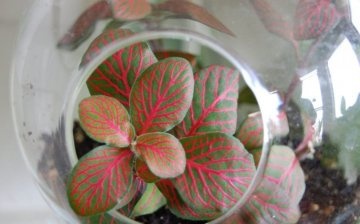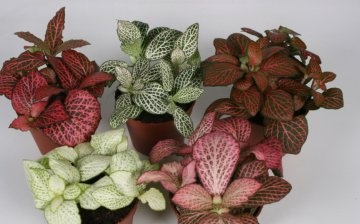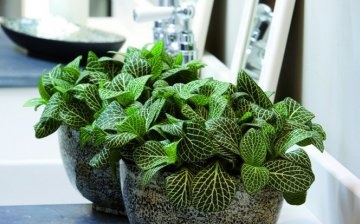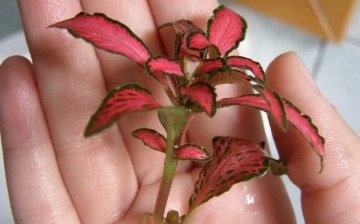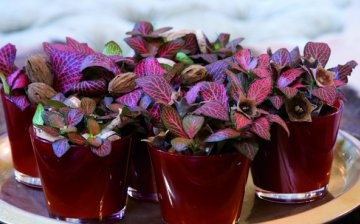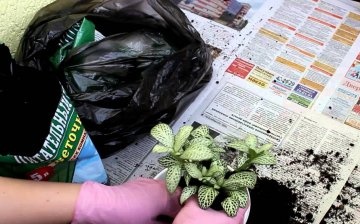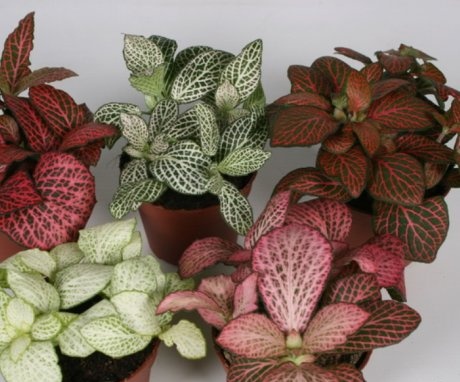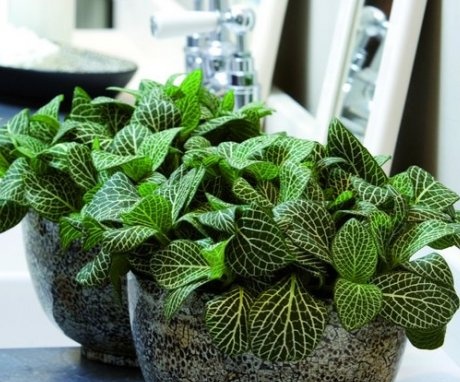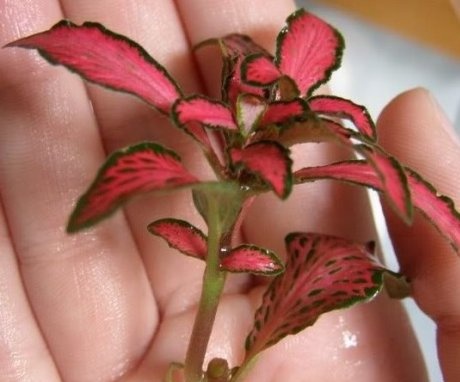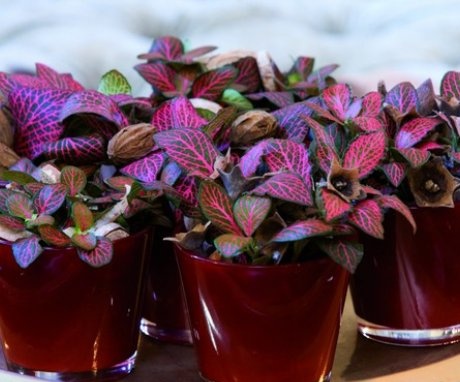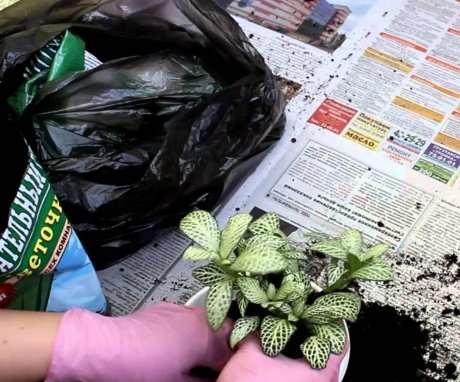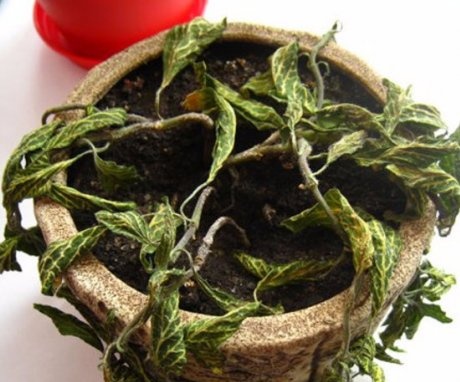Fittonia: reproduction, care and transplantation
Many people love decorative indoor evergreens. Fittonia is one of these types. It is distinguished by an interesting structure of leaves, as well as a peculiar appearance. In order for the shrub to actively develop and delight with its rich green plumage, you need to know how to grow this representative of the flora, and also propagate, if necessary.
Content:
- Description of the plant
- Growing conditions
- Reproduction methods
- Care Tips
- Transfer
- Diseases and pests
Description of the plant
The shrub is native to the South American rainforests. Favorite habitat - Peruvian forests, swampy land. Its genealogy is from the ancient genus Acanthus.
Fittonia is a perennial shrub, small in size, of herbaceous origin. She has branched, flexible stems. They can fall down if the shrub is suspended in a planter or spread over the surface. And some species boast erect leaf petioles. In most cases, the length of the stem on which the leaf blade is located is 10 cm. Most often, the stalk is pubescent with the smallest villi. The leaves are 6 to 12 cm long.
The original color of the leaves is simply mesmerizing to the eyes.
Different types can represent fantastic lace, placed on a green background. Curls can vary in color - from white and pink to yellowish and red tones.
Each flower should have its own flavor. So in Fittonia, the leaves have a kind of uniqueness, but the flowers do not cause much delight. The plant throws out an inconspicuous spike-shaped peduncle. At the end of the stem, white inflorescences of miniature size are formed. Fittonia is a very capricious representative of her kind. She needs special conditions for growth. Therefore, if there is no certain knowledge, you can lose an interesting representative of the natural world.
Growing conditions
The flower prefers well-lit sunny windowsills, but during the midday heat it needs to be shaded. Otherwise, all decorativeness will go away in the near future and the foliage will remain just a green hue. Cuttings with insufficient light conditions are significantly elongated.
Fittonia is very sensitive to temperature changes. The optimal mode for comfortable growth is +25 C for her. But a slight decrease in degrees in the room to +17 C can negatively affect the well-being of the bush. It is not recommended to expose a capricious shrub to drafts, especially in winter. In the summer you can take it outside, but only during the day. At night, it is better to bring the flowerpot back into the room.
Watering for the plant is the most important point.
If there was a slight hitch, and the bush was not watered on time, then the plant reacts very aggressively to the lack of water - it discards the foliage. Alternatively, with a prolonged absence of nutrient moisture, it can dry out completely. At the same time, do not overdo it with watering. With excessive irrigation, the roots quickly rot, which also leads to a disastrous result. It is worth choosing the optimal balance for watering - so that the soil in the pot is always moist, but the water in the pan does not stagnate.
Reproduction methods
Propagating a shrub is no harder than carrying out the same procedure with a less capricious pet. There are several ways to help get a young seedling:
- Air layering.
- Cuttings.
- Shrub division.
Fittonia forms air layers in the leaf axils. In wildlife in this way, it grows over large areas. In living conditions in a small flowerpot, the bush needs help. For this purpose, a separate leaf is sprinkled with earth or, without separating from the common trunk, is pinned with a wire, hairpin or other material to the ground in another container.
Root in a separate flowerpot must be moistened every day in order to create suitable conditions for the formation of roots in a young sprout. With the appearance of young roots and their rooting in the container, the sprout is carefully separated from the mother shrub. Now the new seedling can be left in this flowerpot or transplanted by transfer to a new pot for permanent residence.
The division of the bush is carried out at the time of transplantation of the mother liquor. Cutting off a young sprout is performed at this moment due to the fact that frequent exposure to the bush can result in the death of the pet. It is necessary to separate a part of the plant so that the young plant has a well-developed root system, there are several points of growth. The seedling is planted in a new pot with fresh soil and drainage at the base of the pot.
Reproduction by cuttings is recommended in spring - the optimal period when a shrub, rested after winter, takes root faster with renewed vigor.
But many gardeners prefer to propagate shrubs in this way throughout the year. The cutting is required to be cut from the top of the shoot. The length of the cutting should not exceed 8 cm, and there should be several small leaves on it.
The prepared cutting is planted in a moist soil substrate or light sand. For quick root formation, the seedlings are placed in greenhouse conditions - they are covered with a plastic cup, glass bottle or plastic bag. The temperature in the mini-greenhouse should not fall below +22 C. They must be periodically opened for ventilation and glaze... During the month, the first roots appear, which quickly grow. Now the sprout can be transplanted into a permanent flowerpot for a long stay.
Care Tips
If you follow the simple rules of care, then Fittonia will not force you to constantly monitor your condition. Highlight some care tips:
- Although fittonia is a decorative flower that requires constant lighting, if you grow a young plant by cutting or layering, then the shrub will not only retain its maternal qualities, but also will not be so capricious. He will be able to get along well with little lighting or, conversely, with the south side of the window.
- It is imperative to control the humidity in the room, due to the fact that Fittonia is a big lover of moisture. It is recommended to spray it from a spray bottle at least 2 times a day in dry hot air. Irrigation water should be soft, settled, preferably filtered.
- It is forbidden to use substances for polishing the leaves - they provoke a burn on the delicate leaf surface.
- Watering is carried out only with warm and settled water.
- Pots for planting plants must be purchased wide and low - the root system does not deepen, but diverges to the sides.
- During the active growing season from mid-spring to mid-autumn, it is required to periodically feed the shrub with fertilizers containing minerals.
In a period of 3-4 years, the bush should be transplanted into a new pot with fresh soil. This is necessary when the lower part of the bush is significantly exposed.In addition, you can rejuvenate in another way - by pinching off the upper growth point, then the lateral growth points on the trunk are activated, and the plant will again shine with bright colors.
Transfer
In the first years, the shrub should be replanted annually. For these purposes, a new flowerpot should be prepared, which is 2-3 cm wider than the old one. It is not required to take a very high one, due to the fact that the roots do not have the property of going deep, they grow in breadth.
It is recommended to change the flowerpot in the spring - late March - early April. You can carry out the procedure at a different time, when it is clear that the flowerpot has become small for the plant. You can buy soil for flowers in a specialty store, or you can make it yourself. To do this, you will need to take deciduous soil from the garden in equal proportions, as well as coniferous soil, combine it with coarse-grained sand of river origin.
The soil should be lightweight so that moisture can penetrate well through it.
How to transplant correctly:
- Drainage is laid out at the bottom of the pot - broken brick, pebbles or expanded clay.
- A dense layer of earth is poured on top. It should be tamped lightly so that no hollow holes are formed. Moisture can stagnate in them, which will provoke rotting of the roots.
- Then the shrub is placed. It is best to transplant it by transshipment - a lump of roots with earth is placed on the prepared fresh soil.
- Fresh soil substrate is poured from above and from the sides. Everything is lightly tamped and watered abundantly.
Diseases and pests
Most often, the following problems arise during cultivation:
- The complete death of a shrub is excessive watering, a decrease in air temperature or, conversely, a sharp increase in it, a cold draft.
- The loss of the lower leaf plates is a natural moment in the life of a shrub.
- Yellowing of foliage - frequent watering of the plant. It is necessary to reduce or balance the irrigation process.
- The tips of the leaves turn brown - a problem with mineral fertilizers (excess or deficiency).
- The leaf plates are wrinkled - lack of moisture, dry air. It is required to irrigate the bush from a spray bottle, increase the humidity in the room.
In addition to possible problems, Fittonia is often affected by various pests. The most common uninvited parasitic guests are thrips, mealybugs and red spider mites:
- With thrips, the leaves acquire yellow, enlarging spots. They indicate that insects suck nutritious juices from the plant.
- The scale forms a white fluffy bloom at the base of the foliage.
- Spider mites leave cobwebs on the leaves.
Folk remedies in the form of a soap-ash solution are not very effective, therefore it is advisable to use chemical insecticides.
Thus, Fittonia, although a capricious plant, but with proper care, it will not cause unnecessary work. The main thing is to water on time and monitor lighting and fertilizers. If possible problems with the shrub have formed, then the problem should be looked for in improper care.
More information can be found in the video:



